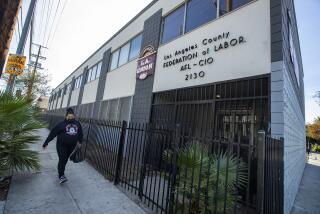Tuesday Night Live : Santa Monica Council Members Compete for TV Viewers
- Share via
It took the cameramen about an hour to match the council members’ names with their faces, and for the first 15 minutes, the director wasn’t even sure if the show was on the air.
But for the most part, all went smoothly late Tuesday as the Santa Monica City Council for the first time allowed a live broadcast of its twice-monthly meetings on cable television.
“We started out shaky,” conceded Marty Stolmack, a member of the six-man crew that produced the six-hour telecast for the city of Santa Monica’s television station, cable Channel 16. “But for a first show, this has gone exceptionally well.”
Compete for Viewers
Still, no one could say for sure if the telecasts would really increase participation in local government--as some council members hoped--or if the council could compete with Johnny Carson and David Letterman for late night and early morning television viewers when the meetings drag on.
Despite the conspicuous presence of three television cameras and bright 2,000-watt lamps, which made some city officials perspire, most of the council members seemed to take their television debut in stride.
“On tricky votes, are we going to have instant replay?,” quipped Councilman William H. Jennings.
“I don’t think the technology has advanced that far yet,” retorted a straight-faced Mayor Dennis Zane.
The council allocated funds for the broadcasts in January, but placed some restrictions on what could be televised. Like their counterparts in the U.S. Congress, the council members will not allow the cameras to show audience reaction or “cutaways” of the lawmakers nodding off or committing other indiscretions.
No Focus on Yawns
“We’re not here to make them look bad, or to catch them in the act if they’re yawning,” said Laura Greenfield, manager of the cable station. “Our job is to be fair and respectful of the elected officials. We’ll only take shots of them if they’re speaking.”
The meeting was broadcast only to Santa Monica residents who subscribe to cable television and was available to about 16,000 households.
Before the meeting began, Greenfield said she was confident her staff of interns and part-time television technicians could pull off the tricky live broadcast. “I have faith in them,” Greenfield said. “Things can go wrong, but I think it’ll be OK.”
As television viewing, the meeting didn’t have the drama and suspense of, say, “Miami Vice” or “L.A. Law.” Among the highlights of the six-hour broadcast were the council’s decision to exempt an 83-year-old woman’s organic garden from a weed abatement program and a long discussion among residents, city administrators and council members about issuing parking permits in one residential neighborhood.
Point Is Information
Council members pointed out that the meeting wasn’t meant to be entertaining, but informative.
“It’s another level of public access,” said Councilwoman Christine E. Reed. “It’s my hope that we can get other agencies of the city involved. It saves people a trip to City Hall.”
Ideally, the council members said, the broadcasts would inspire Santa Monica citizens to step away from the glow of their television screens and drive to City Hall to actually participate in the meetings, something that has been known to happen at other Westside cities that televise council deliberations.
“We’ve had a few cases where people will come to testify at the meetings and say, ‘Hey, I was watching this at home, and I have something to say about this,’ ” said Daniel Bruck, a technician who helps televise Beverly Hills City Council meetings.
City officials in West Hollywood have also received compliments from viewers since the city began transmitting its council meetings in 1986.
“We’ve had excellent response,” said Ian Tanza, the city’s cable television administrator. “It really brings local government to the people.”
When Santa Monica first discussed televising the meetings in January, however, some council members expressed their reluctance.
Councilman David Finkel voted against the proposal because he said there are better uses for the city’s money.
“I’d rather they figure out what it’s going to cost us and give that money to social service providers. We should be giving that money to the homeless.
Besides, Finkel added, the meetings are already broadcast on radio, a medium that he prefers because it “leaves more to the imagination.”
Greenfield said the broadcasts will cost the city about $650 per meeting now, but only $250 per meeting after permanent, remote-control cameras are installed on the walls of the council chambers. Installation is expected in July, she said.
Van Bought
The city also spent about $150,000 for a production van, which will also be used to broadcast basketball games, concerts and other events.
Unfortunately, the city did not have time to publicize the premiere broadcast, and how many viewers actually saw Tuesday’s meeting was uncertain.
During a break in the proceedings shortly before midnight, Councilwoman Reed confirmed that there was at least one viewer. Telephoning her husband at home, she was surprised to discover he was actually watching the broadcast.
“My husband says it’s much easier to follow than on radio,” Reed said. “For him, the most interesting part is seeing the people who are testifying.”
Greenfield said Tuesday’s council meeting will be rebroadcast today and Saturday at 11:30 a.m.
More to Read
Sign up for Essential California
The most important California stories and recommendations in your inbox every morning.
You may occasionally receive promotional content from the Los Angeles Times.













